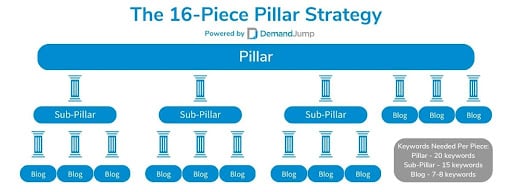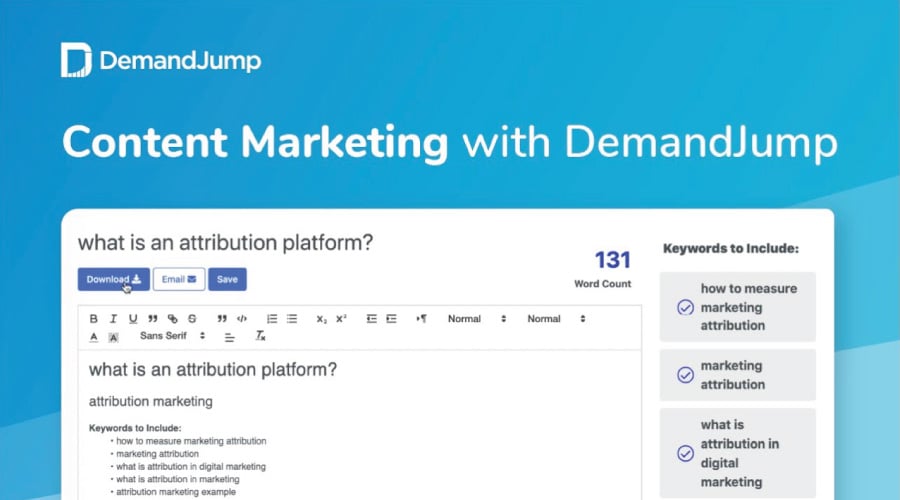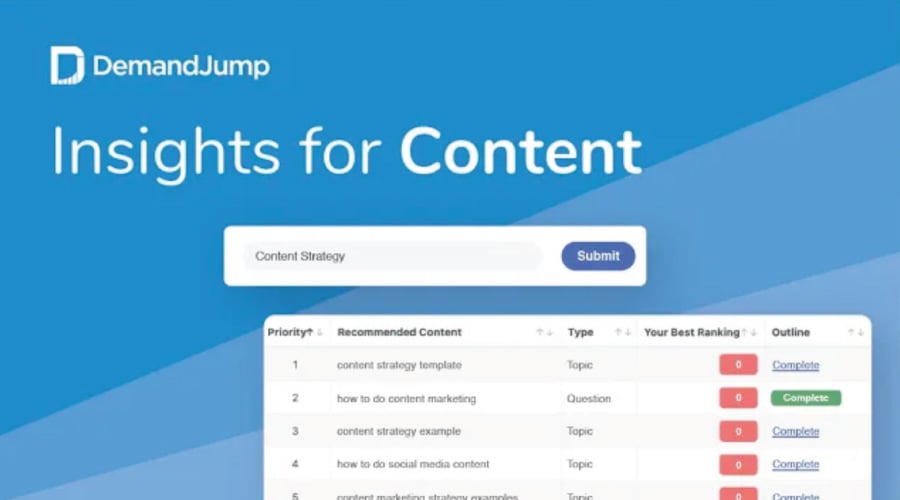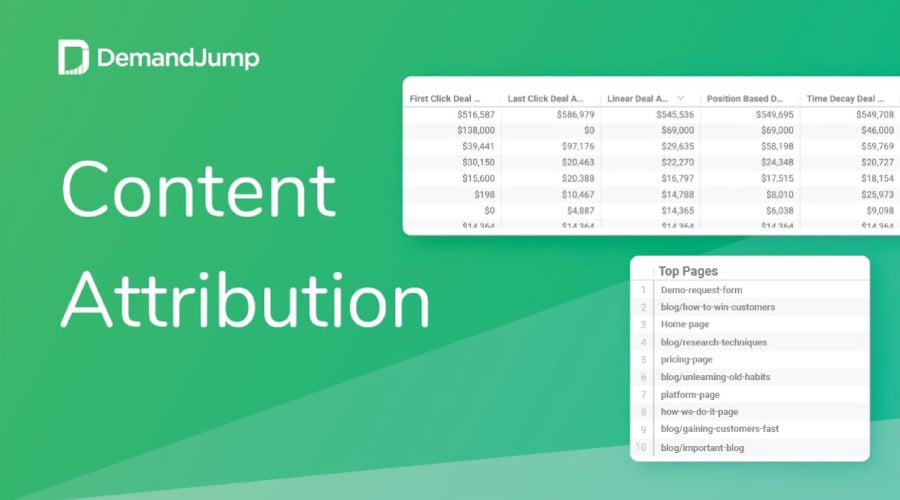The first organic search result on Google gets an average click through rate of over 25%. In other words, one in every four people click on the first organic search result they see. It pays to be number one. The best way to get to that coveted number one spot? With an SEO pillar strategy to build out interrelated, interconnected content that proves to search engines and searchers alike that you’re an authority.

Does that sound like a lot? It doesn’t have to be with the right tools like DemandJump… But let’s not get ahead of ourselves. Now, no one can click through your website links if they don’t even see them. Put another way, if Google and other search engines don’t understand your brand’s content to be helpful and authoritative, it’s simply not going to perform well. That means your work is likely to languish too deep within search engine results pages (SERPs) to get in front of many eyeballs or influence many buying decisions—much less drive any real ROI.
It’s a situation that leaves many digital marketers feeling overwhelmed. Developing an effective SEO-friendly content strategy is vital, but it can feel like trying to master how to play a game governed by rules that are seemingly always changing.
That being said, there is at least one central concept that doesn’t change. People—especially those making a purchasing decision—want to find helpful, informative content online. And guess what: Google also prioritizes well-organized and genuinely helpful content.
This brings up a pair of key questions:
- How do you know what kind of content to create?
- How do you produce and publish content in a way that signals to search engines as well as humans that your brand is a trustworthy authority?
The short answer to each of these questions is “by developing an effective content strategy.”
In this article, we’re going to take a deep-ish dive into how to develop a content pillar strategy that can help you to stand out, get noticed, and engage potential customers. Let’s start by looking at the fundamentals of content strategy. Before we get into the specifics of content pillars in marketing and how to build out an effective content pillar strategy for your company, let’s quickly take a look at content strategy in general.
What Is Content Strategy?
At a high level, content strategy is the overall planning, development, and execution of a company’s content to achieve targeted business goals. Content strategy considers any and all written, visual, and audio content for your audience at every stage of the buyer’s journey.
Content strategy is a dynamic, ongoing process that shapes every aspect of a company’s content, but there are some general things that should be included in every content strategy. So what are the four components of a content strategy?
Goals
What do you want your content to do? What will your calls to action be? For some companies, your goal may be for potential leads to book a demo. Others may want to nurture leads toward a free trial. Others still may be hoping to immediately convert a lead to a customer. Keep in mind that your goals may vary for different pieces of content. Ideally, your content strategy should account for the entire buyer’s journey. Leads in the early stages may be looking for more general educational content while leads in later stages may want whitepapers or case studies that discuss your product or service.
Content Audit
Understanding how your existing content is performing can tell you a lot. If it’s performing well, chances are you’re nailing at least some aspects of your content strategy. Do you get a lot of likes, shares, and comments on social media? You’re posting the right things at the right time. Do you post a lot on your blog but still aren’t seeing many visitors? It might be time to rethink your SEO strategy. At DemandJump, our goal is to help businesses understand the exact content to create to increase first page rankings in search engines—but more on what we do later.
Audience
Most companies have buyer personas, or demographic profiles of their ideal customer. Determine who you’re targeting and write to match that audience. What are their pain points and concerns? Do they respond well to humor or storytelling? What kinds of content do they engage with and on what channels? Be as specific as you can, and keep your audience in mind at every stage.
Content Plan
To create a well-developed content strategy, you must determine what kinds of content you’ll create for every channel you use. Examples might include SEO-driven written content (which we’ll talk more about in the rest of this article), social media videos, podcasts, and more. Ideally, your content strategy should contain a mix of content on different channels to expand your reach.
Once you’ve decided on this information, you can start diving into your content marketing strategies for the various kinds of content you’ll create. A content marketing strategy looks more at the nitty-gritty details, what you’ll write about, workflows, and more. If blogging or SEO content is on your list, a content pillar strategy may be exactly what you need.
What Is a Content Pillar Strategy?
An organic, SEO content pillar strategy is a key component of an overall content strategy for a company. It takes the idea of a content or topic cluster and builds it out into a series of interconnected articles called pillars, sub-pillars, and supporting blogs. Think of your content pillar strategy like a guidebook that lays out what topics you’re going to cover, what questions you’re going to answer, what keywords you’re going to use, and how it all connects into one cohesive set of articles.
The ultimate goal of a content pillar strategy is not only to assist you in writing valuable content that your readers will love (although that’s definitely a huge perk!), it’s also about writing and publishing the kind of content that Google and other search engines see as authoritative. That is what will drive your page one rankings and ultimately better outcomes for your company.
We mentioned a few different types of articles a little bit ago. Let’s circle back to that. How do you define content pillars? Content pillar posts or pages are the individual articles that come together to form your pillar. What are the components of a content pillar? Pillar pages, sub-pillars, and supporting blogs.
- A pillar page is your big-picture, high-level post that your pillar strategy will be built around. It’s a broad overview of your pillar topic. Your pillar page should include anywhere between 15-20 high-value keywords and phrases, and it should be around 3,000 words in length.
- A sub-pillar is a piece of content that dives into a slightly more detailed topic. If your pillar is “Used Cars,” a sub-pillar might look at “Used Cars Under $5000.” Sub-pillars use between 10-15 keywords and phrases and are around 1,500 - 2,000 words in length. Sub-pillars should contain a link to your pillar.
- A supporting blog is a shorter-form piece of content that dives into specific topics—generally, questions people type into Google. On that same topic, a supporting blog may be “What Is the Most Reliable Old Used Car?” Supporting blogs generally contain 5-8 keywords and phrases and are about 750 - 1,000 words in length. Supporting blogs should link up to the sub-pillar they fall under and the pillar.
To help clarify, here’s an illustration of how the pieces described above would interlink to create an authority-building network of quality content:

What Are Some Examples of Content Pillars?
To further illustrate what a content pillar is and what your content strategy might look like for a single topic, let’s take a look at some content pillars examples.
For this example, say you run a company that provides consulting services to help sales teams strengthen and develop their skills. You decide on “sales training program” as your overall pillar topic. That is, this is a high-level topic that you can write a lot about and that has a lot of interrelated subjects that go along with it. Your pillar topic will be the title of your pillar piece, and then you need to identify sub-pillars and supporting blogs to go alongside it. Based on your research, you decide on the following plan.
- Your Pillar Page will be “Sales Training Program.”
- Your Sub-Pillars will be “B2B Sales Training Programs,” “Sales Training Topics 2023,” and “Innovative Sales Training Techniques.” Each Sub-Pillar will contain a link to the Pillar Page.
- You will write 12 Supporting Blogs. Of those:
- 3 will link directly to the Pillar Page only.
- 3 will link to the “B2B Sales Training Programs” Sub-Pillar in addition to the Pillar Page.
- 3 will link to the “Sales Training Topics 2023” Sub-Pillar in addition to the Pillar Page.
- 3 will link to the “Innovative Sales Training Techniques” Sub-Pillar in addition to the Pillar Page.
To expand on our example strategy, let’s look at how 12 Supporting Blog topics would align with the Pillar Page and Sub-Pillar topics.
First, the 3 Supporting Blogs that link only to the Pillar Page will address topics related to the general concept of sales training programs:

For the first Sub-Pillar, you identify three topics related to B2B sales training programs. Each of these Supporting Blogs would contain links to the main Pillar Page as well as the first Sub-Pillar topic.

The next 3 Supporting Blogs would link back to the “Sales Training Topics 2023” Sub-Pillar (as well as the main Pillar Page).

The final 3 Supporting Blogs would link back to the “Innovative Sales Training Techniques” Sub-Pillar (as well as the main Pillar Page).

You can use the above content pillar template as you build out your own pillars. Ideally, each pillar should have at least 16 pieces of interrelated content: 1 pillar, 3 sub-pillars, and 12 blogs. Remember, your sub-pillars should all link up to your pillar and your blogs should link up to your sub-pillars and pillars. Doing so will give each higher level piece more credibility from an SEO standpoint—boosting your pillar to be an authority.
How to Create Content Pillars with Strategy
So how do you go from the example above to a fleshed out content pillar strategy? Just follow these steps!
1. Determine Your Topic
Before you get started, you have to decide what your pillar topic will be. How do you identify content pillars? Think through what your primary business focus is and go from there. Do you sell cars? Do you train sales teams? Do you offer a software solution for accounting? Focus on those key business focuses, and remember to keep it broad. Typically, two to three word titles, like “sales training program,” “used cars,” or “accounting software” will ensure you’ve got a big enough topic to work through.
2. Decide on Sub-Pillars and Supporting Blogs
Once you have your content pillar topic decided, you need to choose sub-pillars and supporting blogs. There are a couple of ways to do this: manually and with the help of a platform like DemandJump.
First, you could do it the manual way using search engines like Google. Simply search your content pillar topic and look for Google’s People Also Ask and Related Searches features for connected topics. If we search “sales training program” in Google, you’ll see that under Related Searches are topics like “top sales training programs 2021,” “sales training programs free,” and “sales training program example.” These are broad enough topics that they could be used as sub-pillars. Under People Also Ask you might see questions like “what should a sales program include,” and “what are training needs for a sales team?” Keep searching until you’ve established your topics for the sub-pillars and supporting-blogs.
That can take time, though, and there’s a bit of gut instinct and guessing that goes into it. Alternatively, you could use a platform like DemandJump. Once you run an insight report on your pillar topic, DemandJump’s dedicated Pillar Strategy tool can generate the highest-value keywords and questions and recommend which pieces should be sub-pillars and which should be supporting blogs. We pulled the topics in the “sales training program” right out of our Pillar Strategy tool, but here’s a screenshot of it in real time.

Once you’ve identified all your topics, it can be helpful to lay them all out in a pillar content strategy template in Excel or Google Docs to keep everything organized. There, you can also track workflows, keywords, revision processes, and more.
3. Choose Your Keywords
You’ve got your topics, now you need to select high-value keywords. Like the previous step, there’s a manual and an automated way to move forward with this. Manually, you could do keyword research with tools like Google Keyword Planner, Answer The Public, Google Trends, or Wordstream. These free or freemium tools can provide you with information on what people are actually searching for around your topic. It can take time, though, and you may not find everything you need.
That’s where DemandJump comes in. After you build out a pillar plan, you can easily generate one-click Content Briefs that provide you with a list of the highest-value keywords and phrases. Simply choose the ones that make the most sense for your article and that’s it! No lengthy research, just let our automated tools give you the keywords you need to improve your rankings and get to page one. Need more information on keyword research? We’ve got you covered with a wealth of articles on the subject!
4. Start Writing
Once you’ve got your titles and your keywords, you can start writing. And this is where we come full circle to our original discussion around high-level content strategy. With any content you’re developing, keep in mind your goals, audience, where they are in the buyer’s journey, and more. And remember, good content doesn’t just sell. It’s also about engaging with your audience, educating them, and inspiring them to take action.
DemandJump's podcast, Page One or Bust!, often discusses Pillar-Based Marketing best practices. In the clip below, some of DemandJump's writers discuss how to construct their Pillars. For the full episode, visit this link.
DemandJump: Powering the Best Content Marketing Strategies in 2022 and Beyond
Organic SEO content marketing is an ever-moving target. You deserve a tool that can provide you with the kinds of insights you need to drive better outcomes for your business. DemandJump was built for marketers by marketers as a data-driven approach to content marketing, keyword research, pillar page strategy, content strategy, and marketing attribution.
With DemandJump, developing a content pillar strategy, finding keywords, and deciding the exact content to create is just a few clicks away.
















